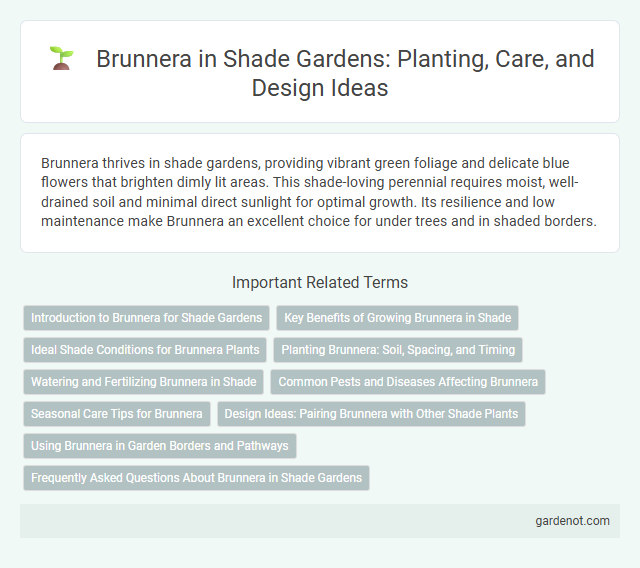Brunnera thrives in shade gardens, providing vibrant green foliage and delicate blue flowers that brighten dimly lit areas. This shade-loving perennial requires moist, well-drained soil and minimal direct sunlight for optimal growth. Its resilience and low maintenance make Brunnera an excellent choice for under trees and in shaded borders.
Introduction to Brunnera for Shade Gardens
Brunnera, commonly known as Siberian Bugloss, is a hardy perennial renowned for its vibrant heart-shaped leaves and tiny blue forget-me-not-like flowers, making it an ideal choice for shade gardens. Thriving in partial to full shade, Brunnera requires well-drained, consistently moist soil, offering excellent ground cover and contrasting foliage beneath trees and shrubs. Its resilience to deer and ability to brighten dim garden corners with striking variegated cultivars establish Brunnera as a valuable plant for enhancing shade garden aesthetics.
Key Benefits of Growing Brunnera in Shade
Brunnera thrives in shaded garden areas, providing lush, heart-shaped foliage that brightens dark corners with vibrant green leaves often adorned with silver variegation. This shade-tolerant perennial offers early spring blooms of delicate, forget-me-not-like blue flowers that attract pollinators, enhancing biodiversity in shady landscapes. Its low-maintenance nature and resistance to deer make Brunnera an ideal groundcover for shaded spots, reducing soil erosion while maintaining garden aesthetics.
Ideal Shade Conditions for Brunnera Plants
Brunnera thrives best in partial to full shade environments, ideally receiving dappled sunlight or morning sun with afternoon shade to prevent leaf scorch. Moist, well-drained soil rich in organic matter enhances its growth, maintaining consistent humidity without waterlogging. These conditions replicate its native woodland habitat, ensuring vibrant foliage and prolific blue flowers.
Planting Brunnera: Soil, Spacing, and Timing
Brunnera thrives in rich, moist, well-drained soil with a pH range of 6.0 to 7.5, ideal for shade gardens where consistent moisture supports its growth. Plant Brunnera rhizomes 12 to 18 inches apart to allow ample space for spreading and healthy airflow, preventing fungal diseases. The best time to plant is early spring or fall, enabling the plant to establish roots before intense summer heat or winter cold.
Watering and Fertilizing Brunnera in Shade
Brunnera thrives in consistently moist soil, requiring regular watering to prevent drought stress, especially during dry periods in shaded gardens. Applying a balanced, slow-release fertilizer in early spring boosts growth and enhances the vibrant blue flowers typical of healthy Brunnera plants. Avoid over-fertilizing to prevent excessive foliage growth at the expense of blooms, ensuring optimal plant health in low-light conditions.
Common Pests and Diseases Affecting Brunnera
Brunnera is commonly affected by pests such as slugs and aphids, which can cause significant damage to its leaves, leading to unsightly holes and reduced plant vigor. Powdery mildew is a frequent fungal disease impacting Brunnera, characterized by white, powdery spots on the foliage that can stunt growth if left untreated. Proper spacing and adequate air circulation help prevent these issues, while organic treatments like neem oil or insecticidal soap effectively manage pest infestations without harming the plant's environment.
Seasonal Care Tips for Brunnera
Brunnera thrives in shaded garden areas with consistently moist, well-drained soil and benefits from a layer of organic mulch to retain moisture during dry spells. Prune dead or damaged foliage in early spring to encourage fresh growth and remove spent flower stalks after blooming to maintain plant health. Applying a balanced, slow-release fertilizer in early spring supports robust development and vibrant, heart-shaped leaves throughout the growing season.
Design Ideas: Pairing Brunnera with Other Shade Plants
Brunnera thrives in shaded garden areas and pairs beautifully with hostas, ferns, and astilbes to create layered textures and varying shades of green. Its heart-shaped, silver-speckled leaves complement the lush foliage of these shade-loving plants, enhancing visual interest and depth. Combining Brunnera with spring bulbs like hellebores or snowdrops brings early-season color, making the shade garden vibrant throughout multiple seasons.
Using Brunnera in Garden Borders and Pathways
Brunnera is an excellent choice for garden borders and pathways due to its lush, heart-shaped leaves and delicate blue flowers that provide vibrant, lasting color in shaded areas. Its dense foliage creates a natural edge, defining garden spaces while preventing soil erosion along walkways. Low-maintenance and shade-tolerant, Brunnera thrives in woodland gardens, adding texture and visual interest without overwhelming surrounding plants.
Frequently Asked Questions About Brunnera in Shade Gardens
Brunnera thrives in shade gardens due to its preference for partial to full shade and moist, well-drained soil, making it ideal for low-light areas. It is resistant to deer and fairly low-maintenance, requiring minimal watering once established and benefiting from mulching to retain soil moisture. Common questions include its cold hardiness, which extends to USDA zones 3-8, and its potential to spread via rhizomes, allowing gardeners to control growth by dividing clumps every few years.
Brunnera Infographic

 gardenot.com
gardenot.com